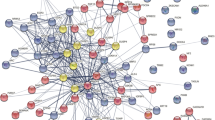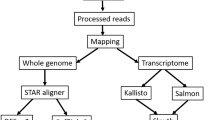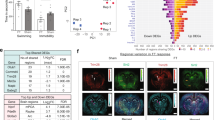Abstract
Both the prototypic tricyclic antidepressant imipramine (IMI) and the herbal product St John's wort (SJW) can be effective in the treatment of major depressive disorder. We studied hypothalamic gene expression in rats treated with SJW or IMI to test the hypothesis that chronic antidepressant treatment by various classes of drugs results in shared patterns of gene expression that may underlie their therapeutic effects. Individual hypothalami were hybridized to individual Affymetrix chips; we studied three arrays per group treatment. We constructed 95% confidence intervals for expression fold change for genes present in at least one treatment condition and we considered genes to be differentially expressed if they had a confidence interval excluding 1 (or −1) and had absolute difference in expression value of 10 or greater. SJW treatment differentially regulated 66 genes and expression sequence tags (ESTs) and IMI treatment differentially regulated 74 genes and ESTs. We found six common transcripts in response to both treatments. The likelihood of this occurring by chance is 1.14 × 10−23. These transcripts are relevant to two molecular machines, namely the ribosomes and microtubules, and one cellular organelle, the mitochondria. Both treatments also affected different genes that are part of the same cell function processes, such as glycolytic pathways and synaptic function. We identified single-nucleotide polymorphisms in the human orthologs of genes regulated both treatments, as those genes may be novel candidates for pharmacogenetic studies. Our data support the hypothesis that chronic antidepressant treatment by drugs of various classes may result in a common, final pathway of changes in gene expression in a discrete brain region.
This is a preview of subscription content, access via your institution
Access options
Subscribe to this journal
Receive 12 print issues and online access
$259.00 per year
only $21.58 per issue
Buy this article
- Purchase on Springer Link
- Instant access to full article PDF
Prices may be subject to local taxes which are calculated during checkout





Similar content being viewed by others
References
Muller WE, Kasper S . Clinically used antidepressant drugs. Pharmacopsychiatry 1997; 30(Suppl 2): 71.
Group HDTS . Effect of Hypericum perforatum (St John's wort) in major depressive disorder: a randomized controlled trial. JAMA 2002; 287: 1807–1814.
Shelton RC, Keller MB, Gelenberg A, Dunner DL, Hirschfeld R, Thase ME et al. Effectiveness of St John's wort in major depression: a randomized controlled trial. JAMA 2001; 285: 1978–1986.
Linde K, Ramirez G, Mulrow CD, Pauls A, Weidenhammer W, Mel D . St John's wort for depression—an overview and meta-analysis of randomised clinical trials. BMJ 1996; 313: 253–258.
Stevinson C, Ernst E . Hypericum for depression. An update of the clinical evidence. Eur Neuropsychopharmacol 1999; 9: 501–505.
Lecrubier Y, Clerc G, Didi R, Kieser M . Efficacy of St. John's wort extract WS 5570 in major depression: a double-blind, placebo-controlled trial. Am J Psychiatry 2002; 159: 1361–1366.
Piscitelli SC, Kress DR, Bertz RJ, Pau A, Davey R . The effect of ritonavir on the pharmacokinetics of meperidine and normeperidine. Pharmacotherapy 2000; 20: 549–553.
Ruschitzka F, Meier PJ, Turina M, Luscher TF, Noll G . Acute heart transplant rejection due to Saint John's wort. Lancet 2000; 355: 548–549.
Barnes J, Mills SY, Abbot NC, Willoughby M, Ernst E . Different standards for reporting ADRs to herbal remedies and conventional OTC medicines: face-to-face interviews with 515 users of herbal remedies. Br J Clin Pharmacol 1998; 45: 496–500.
Muller WE, Rolli M, Schafer C, Hafner U . Effects of hypericum extract (LI 160) in biochemical models of antidepressant activity. Pharmacopsychiatry 1997; 2: 102–107.
Muller WE, Singer A, Wonnemann M, Hafner U, Rolli M, Schafer C . Hyperforin represents the neurotransmitter reuptake inhibiting constituent of hypericum extract. Pharmacopsychiatry 1998; 1: 16–21.
Neary JT, Bu Y . Hypericum LI 160 inhibits uptake of serotonin and norepinephrine in astrocytes. Brain Res 1999; 816: 358–363.
Kaehler ST, Sinner C, Chatterjee SS, Philippu A . Hyperforin enhances the extracellular concentrations of catecholamines, serotonin and glutamate in the rat locus coeruleus. Neurosci Lett 1999; 262: 199–202.
Chatterjee SS, Bhattacharya SK, Wonnemann M, Singer A, Muller WE . Hyperforin as a possible antidepressant component of hypericum extracts. Life Sci 1998; 63: 499–510.
Butterweck V, Winterhoff H, Herkenham M . St John's wort, hypericin, and imipramine: a comparative analysis of mRNA levels in brain areas involved in HPA axis control following short-term and long-term administration in normal and stressed rats. Mol Psychiatry 2001; 6: 547–564.
Erdelmeier CA . Hyperforin, possibly the major non-nitrogenous secondary metabolite of Hypericum perforatum L. Pharmacopsychiatry 1998; 1: 2–6.
Wong ML, Khatri P, Licinio J, Esposito A, Gold PW . Identification of hypothalamic transcripts upregulated by antidepressants. Biochem Biophys Res Commun 1996; 229: 275–279.
Berridge MJ, Downes CP, Hanley MR . Neural and developmental actions of lithium: a unifying hypothesis. Cell 1989; 59: 411–419.
Manji HK, Chen G . PKC, MAP kinases and the bcl-2 family of proteins as long-term targets for mood stabilizers. Mol Psychiatry 2002; 7(Suppl 1): S46–S56.
Williams RS, Cheng L, Mudge AW, Harwood AJ . A common mechanism of action for three mood-stabilizing drugs. Nature 2002; 417: 292–295.
Wong M-L, Licinio J . Research and treatment approaches to depression. Nature Rev Neurosci 2001; 2: 343–351.
Gold PW, Wong ML, Chrousos GP, Licinio J . Stress system abnormalities in melancholic and atypical depression: molecular, pathophysiological, and therapeutic implications. Mol Psychiatry 1996; 1: 257–264.
Brady LS, Whitfield Jr HJ, Fox RJ, Gold PW, Herkenham M . Long-term antidepressant administration alters corticotropin-releasing hormone, tyrosine hydroxylase, and mineralocorticoid receptor gene expression in rat brain. Therapeutic implications. J Clin Invest 1991; 87: 831–837.
Brady LS, Gold PW, Herkenham M, Lynn AB, Whitfield Jr HJ . The antidepressants fluoxetine, idazoxan and phenelzine alter corticotropin-releasing hormone and tyrosine hydroxylase mRNA levels in rat brain: therapeutic implications. Brain Res 1992; 572: 117–125.
Reul JM, Stec I, Soder M, Holsboer F . Chronic treatment of rats with the antidepressant amitriptyline attenuates the activity of the hypothalamic–pituitary–adrenocortical system. Endocrinology 1993; 133: 312–320.
Bhattacharya SK, Chakrabarti A, Chatterjee SS . Activity profiles of two hyperforin-containing hypericum extracts in behavioral models. Pharmacopsychiatry 1998; 1: 22–29.
Li C, Wong WH . Model-based analysis of oligonucleotide arrays: expression index computation and outlier detection. Proc Natl Acad Sci USA 2001; 98: 31–36.
Lockhart DJ, Barlow C . Expressing what's on your mind: DNA arrays and the brain. Nat Rev Neurosci 2001; 2: 63–68.
Slonim DK . From patterns to pathways: gene expression data analysis comes of age. Nat Genet 2002; 32(Suppl): 502–508.
Zhang MQ . Large-scale gene expression data analysis: a new challenge to computational biologists. Genome Res 1999; 9: 681–688.
Rice JA . Mathematical Statistics and Data Analysis. Wadsworth Publishing Company: Pacific Grove, CA, 1988.
Olshen AB, Jain AN . Deriving quantitative conclusions from microarray expression data. Bioinformatics 2002; 18: 961–970.
Chu S, DeRisi J, Eisen M, Mulholland J, Botstein D, Brown PO et al. The transcriptional program of sporulation in budding yeast. Science 1998; 282: 699–705.
DeRisi JL, Iyer VR, Brown PO . Exploring the metabolic and genetic control of gene expression on a genomic scale. Science 1997; 278: 680–686.
Schena M, Shalon D, Heller R, Chai A, Brown PO, Davis RW . Parallel human genome analysis: microarray-based expression monitoring of 1000 genes. Proc Natl Acad Sci USA 1996; 93: 10614–10619.
Wodicka L, Dong H, Mittmann M, Ho MH, Lockhart DJ . Genome-wide expression monitoring in Saccharomyces cerevisiae. Nat Biotechnol 1997; 15: 1359–1367.
Fambrough D, McClure K, Kazlauskas A, Lander ES . Diverse signaling pathways activated by growth factor receptors induce broadly overlapping, rather than independent, sets of genes. Cell 1999; 97: 727–741.
Holstege FC, Jennings EG, Wyrick JJ, Lee TI, Hengartner CJ, Green MR et al. Dissecting the regulatory circuitry of a eukaryotic genome. Cell 1998; 95: 717–728.
Eisen MB, Spellman PT, Brown PO, Botstein D . Cluster analysis and display of genome-wide expression patterns. Proc Natl Acad Sci USA 1998; 95: 14863–14868.
Michelson D, Galliven E, Hill L, Demitrack M, Chrousos G, Gold P . Chronic imipramine is associated with diminished hypothalamic–pituitary–adrenal axis responsivity in healthy humans. J Clin Endocrinol Metab 1997; 82: 2601–2606.
Wool IG . Extraribosomal functions of ribosomal proteins. Trends Biochem Sci 1996; 21: 164–165.
Edgar VA, Sterin-Borda L, Cremaschi GA, Genaro AM . Role of protein kinase C and cAMP in fluoxetine effects on human T-cell proliferation. Eur J Pharmacol 1999; 372: 65–73.
Genaro AM, Edgar VA, Sterin-Borda L . Differential effects of fluoxetine on murine B-cell proliferation depending on the biochemical pathways triggered by distinct mitogens. Biochem Pharmacol 2000; 60: 1279–1283.
Manev H, Uz T, Smalheiser NR, Manev R . Antidepressants alter cell proliferation in the adult brain in vivo and in neural cultures in vitro. Eur J Pharmacol 2001; 411: 67–70.
Miyamoto S, Asakura M, Sasuga Y, Osada K, Bodaiji N, Imafuku J et al. Effects of long-term treatment with desipramine on microtubule proteins in rat cerebral cortex. Eur J Pharmacol 1997; 333: 279–287.
Spillantini MG, Murrell JR, Goedert M, Farlow MR, Klug A, Ghetti B . Mutation in the tau gene in familial multiple system tauopathy with presenile dementia. Proc Natl Acad Sci USA 1998; 95: 7737–7741.
Hutton M, Lendon CL, Rizzu P, Baker M, Froelich S, Houlden H et al. Association of missense and 5′-splice-site mutations in tau with the inherited dementia FTDP-17. Nature 1998; 393: 702–705.
Mata M, Fink DJ, Gainer H, Smith CB, Davidsen L, Savaki H et al. Activity-dependent energy metabolism in rat posterior pituitary primarily reflects sodium pump activity. J Neurochem 1980; 34: 213–215.
Gerber III JC, Choki J, Brunswick DJ, Reivich M, Frazer A . The effect of antidepressant drugs on regional cerebral glucose utilization in the rat. Brain Res 1983; 269: 319–325.
Katyare SS, Rajan RR . Effect of long-term in vivo treatment with imipramine on the oxidative energy metabolism in rat brain mitochondria. Comp Biochem Physiol C Pharmacol Toxicol Endocrinol 1995; 112: 353–357.
Eto K, Fukuda T, Araki Y, Inoue B, Ogata M . Effect of tricyclic drugs on mitochondrial membrane. Acta Med Okayama 1985; 39: 289–295.
Burbenskaya NM, Nartsissov YR, Tsofina LM, Komissarova IA . The uncoupling effect of some psychotropic drugs on oxidative phosphorylation in rat liver mitochondria. Biochem Mol Biol Int 1998; 45: 261–268.
Maximov V, Martynenko A, Hunsmann G, Tarantul V . Mitochondrial 16S rRNA gene encodes a functional peptide, a potential drug for Alzheimer's disease and target for cancer therapy. Med Hypotheses 2002; 59: 670–673.
Roth JA, Gillis CN . Inhibition of lung, liver and brain monoamine oxidase by imipramine and desipramine. Biochem Pharmacol 1974; 23: 1138–1140.
Nag M, Nandi N . In vitro and in vivo effect of chloropromazine, imipramine and lithium chloride on monoamine oxidase activity in rat brain mitochondria. Biosci Rep 1987; 7: 701–704.
Egashira T, Takayama F, Yamanaka Y . Effects of long-term treatment with dicyclic, tricyclic, tetracyclic, and noncyclic antidepressant drugs on monoamine oxidase activity in mouse brain. Gen Pharmacol 1996; 27: 773–778.
Kodavanti UP, Mehendale HM . Cationic amphiphilic drugs and phospholipid storage disorder. Pharmacol Rev 1990; 42: 327–354.
Xia Z, Appelkvist EL, DePierre JW, Nassberger L . Tricyclic antidepressant-induced lipidosis in human peripheral monocytes in vitro, as well as in a monocyte-derived cell line, as monitored by spectrofluorimetry and flow cytometry after staining with Nile red. Biochem Pharmacol 1997; 53: 1521–1532.
Lin FH, Lin R, Wisniewski HM, Hwang YW, Grundke-Iqbal I, Healy-Louie G et al. Detection of point mutations in codon 331 of mitochondrial NADH dehydrogenase subunit 2 in Alzheimer's brains. Biochem Biophys Res Commun 1992; 182: 238–246.
Corral-Debrinski M, Horton T, Lott MT, Shoffner JM, McKee AC, Beal MF et al. Marked changes in mitochondrial DNA deletion levels in Alzheimer brains. Genomics 1994; 23: 471–476.
Davis RE, Miller S, Herrnstadt C, Ghosh SS, Fahy E, Shinobu LA et al. Mutations in mitochondrial cytochrome c oxidase genes segregate with late-onset Alzheimer disease. Proc Natl Acad Sci USA 1997; 94: 4526–4531.
Boeke JD, Garfinkel DJ, Styles CA, Fink GR . Ty elements transpose through an RNA intermediate. Cell 1985; 40: 491–500.
Yamada M, Takahashi K, Tsunoda M, Nishioka G, Kudo K, Ohata H et al. Differential expression of VAMPs/synaptobrevin-2 after antidepressant and electroconvulsive treatment in rat frontal cortex. Pharmacogenomics J 2003; 2: 377–382.
Manji HK, Drevets WC, Charney DS . The cellular neurobiology of depression. Nat Med 2001; 7: 541–547.
Dahmen N, Fehr C, Reuss S, Hiemke C . Stimulation of immediate early gene expression by desipramine in rat brain. Biol Psychiatry 1997; 42: 317–323.
Torres G, Horowitz JM, Laflamme N, Rivest S . Fluoxetine induces the transcription of genes encoding c-fos, corticotropin-releasing factor and its type 1 receptor in rat brain. Neuroscience 1998; 87: 463–477.
Johansson IM, Bjartmar L, Marcusson J, Ross SB, Seckl JR, Olsson T . Chronic amitriptyline treatment induces hippocampal NGFI-A, glucocorticoid receptor and mineralocorticoid receptor mRNA expression in rats. Brain Res Mol Brain Res 1998; 62: 92–95.
Bjartmar L, Johansson IM, Marcusson J, Ross SB, Seckl JR, Olsson T . Selective effects on NGFI-A, MR, GR and NGFI-B hippocampal mRNA expression after chronic treatment with different subclasses of antidepressants in the rat. Psychopharmacology (Berlin) 2000; 151: 7–12.
Thome J, Sakai N, Shin K, Steffen C, Zhang YJ, Impey S et al. cAMP response element-mediated gene transcription is upregulated by chronic antidepressant treatment. J Neurosci 2000; 20: 4030–4036.
Chen J, Nye HE, Kelz MB, Hiroi N, Nakabeppu Y, Hope BT et al. Regulation of delta FosB and FosB-like proteins by electroconvulsive seizure and cocaine treatments. Mol Pharmacol 1995; 48: 880–889.
Reti IM, Baraban JM . Sustained increase in Narp protein expression following repeated electroconvulsive seizure. Neuropsychopharmacology 2000; 23: 439–443.
Nibuya M, Nestler EJ, Duman RS . Chronic antidepressant administration increases the expression of cAMP response element binding protein (CREB) in rat hippocampus. J Neurosci 1996; 16: 2365–2372.
Landgrebe J, Welzl G, Metz T, van Gaalen MM, Ropers H, Wurst W et al. Molecular characterisation of antidepressant effects in the mouse brain using gene expression profiling. J Psychiatr Res 2002; 36: 119–129.
Acknowledgements
We thank Aaron Bertalmio, Xueying Gu, Che Hutson, and Dr João R Oliveira for their technical help. We express our gratitude to Botanicals International for providing a large amount of SJW extract from a single lot for our studies, and to Dr. H. Howardsun from Pharmanox for his analysis of SJW extract. We thank Drs. David Heber and Vay Lian W. Go for their support.
This work was supported by NIH grants AT00151, MH062777, RR00865, and RR017365 (M-LW), RR017611, RR016996, HL004526, DK058851, DK063240, HG002500, and GM061394 (JL), and by awards from NARSAD (ML-W), Dana Foundation, and Stanley Foundation (JL), and the Neuropsychiatric Institute (University of California, Los Angeles, CA, USA).
Author information
Authors and Affiliations
Corresponding author
Rights and permissions
About this article
Cite this article
Wong, ML., O'Kirwan, F., Hannestad, J. et al. St John's wort and imipramine-induced gene expression profiles identify cellular functions relevant to antidepressant action and novel pharmacogenetic candidates for the phenotype of antidepressant treatment response. Mol Psychiatry 9, 237–251 (2004). https://doi.org/10.1038/sj.mp.4001470
Received:
Revised:
Accepted:
Published:
Issue Date:
DOI: https://doi.org/10.1038/sj.mp.4001470
Keywords
This article is cited by
-
Delineation of molecular pathway activities of the chronic antidepressant treatment response suggests important roles for glutamatergic and ubiquitin–proteasome systems
Translational Psychiatry (2017)
-
Analysis of region-specific changes in gene expression upon treatment with citalopram and desipramine reveals temporal dynamics in response to antidepressant drugs at the transcriptome level
Psychopharmacology (2012)
-
Profiling of hypothalamic and hippocampal gene expression in chronically stressed rats treated with St. John’s wort extract (STW 3-VI) and fluoxetine
Psychopharmacology (2011)
-
Corticolimbic Transcriptome Changes are State-Dependent and Region-Specific in a Rodent Model of Depression and of Antidepressant Reversal
Neuropsychopharmacology (2009)
-
Merger of Ayurveda and Tissue Culture-Based Functional Genomics: Inspirations from Systems Biology
Journal of Translational Medicine (2008)



